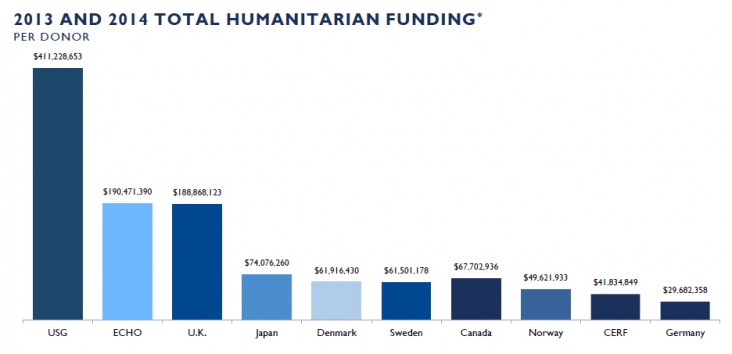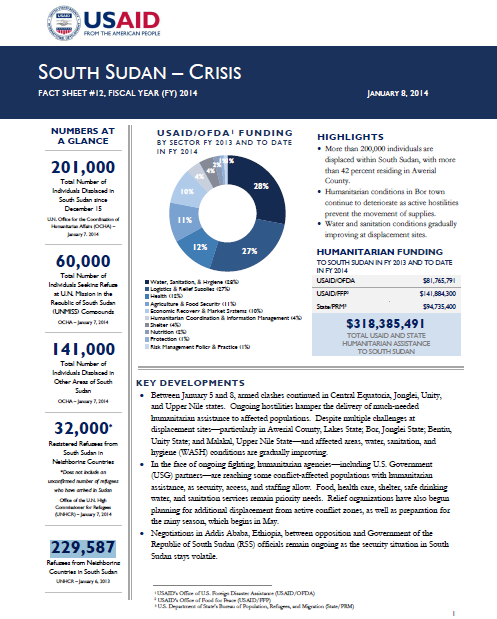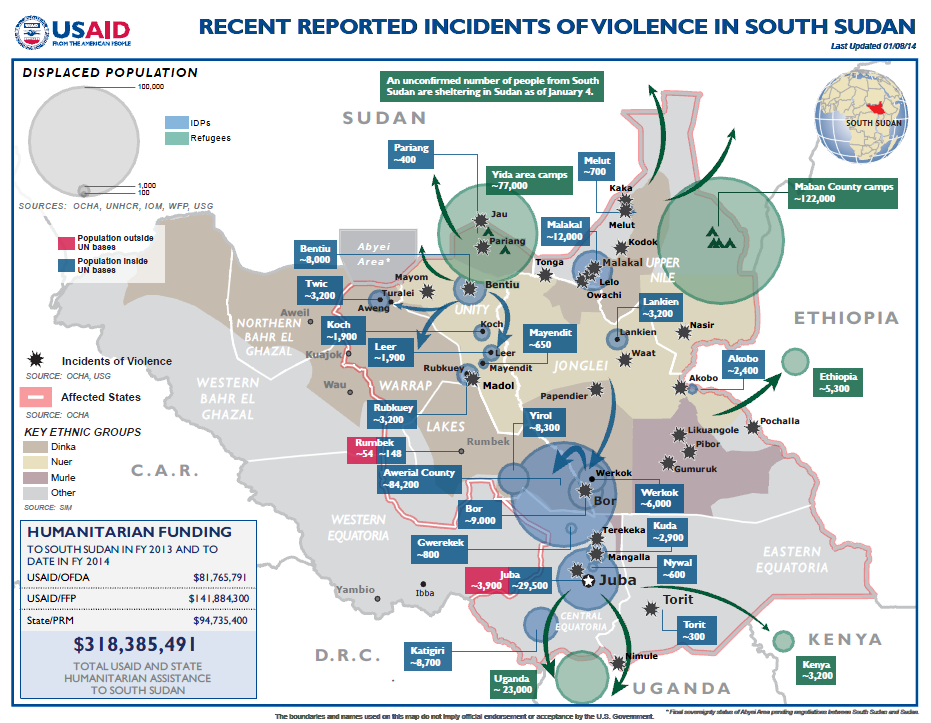- What We Do
- Agriculture and Food Security
- Democracy, Human Rights and Governance
- Economic Growth and Trade
- Education
- Environment and Global Climate Change
- Gender Equality and Women's Empowerment
- Global Health
- Humanitarian Assistance
- Transformation at USAID
- Water and Sanitation
- Working in Crises and Conflict
- U.S. Global Development Lab
Speeches Shim
January 10, 2013
Numbers At A Glance
201,000
60,000
141,000
43,000
229,587
Humanitarian Funding:
To South Sudan To Date In FY2013 and FY2014:
| USAID/OFDA | $81,765,791 |
| USAID/FFP | $141,884,300 |
| State/PRMDoD | $94,735,400 |
| TOTAL | $318,385,491 |
Highlights
Death toll from violence sparked in South Sudan in mid-December far exceeds 1,000, U.N. reports.
Number of South Sudanese refugees in Uganda now 32,000.
Nutrition and health activities, including immunization campaigns, continue to reach additional displaced populations throughout the country.
KEY DEVELOPMENTS
On January 9, Under-Secretary-General for Peacekeeping Operations Hervé Ladsous reported that the death toll stemming from ongoing violence that broke out in South Sudan on December 15 is substantially higher than the 1,000 deaths cited to date. While no current casualty figures are available, the U.N. highlighted the critical situation throughout the country.
As of January 8, approximately 43,000 South Sudanese refugees had fled to neighboring countries, according to the U.N. High Commissioner for Refugees (UNHCR). Approximately 32,000 South Sudanese refugees had arrived in Uganda, 4,700 in Kenya’s Kakuma Refugee Camp, and an estimated 6,000 in Ethiopia. Reports indicate an unconfirmed number of refugees have also sought refuge in Sudan.
Despite multiple challenges in affected areas and displacement sites—particularly in Awerial County, Lakes State; Bor, Jonglei State; Bentiu, Unity State; and Malakal, Upper Nile State—water, sanitation, and hygiene (WASH) conditions are gradually improving. Food, health care, shelter, safe drinking water, and sanitation services remain priority needs. Relief organizations have begun planning for additional displacement from active conflict zones, as well as for the upcoming rainy season.
SITUATION AND DISPLACEMENT UPDATE
Ongoing hostilities in many areas of South Sudan continue to impede the delivery of critical humanitarian assistance to vulnerable populations. Despite constraints, humanitarian agencies are providing support as access and security allow.
During the week of January 6, armed clashes continued in Central Equatoria, Jonglei, Unity, and Upper Nile states. The U.N. reported that heavy fighting broke out on January 8 between Sudan People’s Liberation Army (SPLA) and opposition forces in Mayom County, Unity State, forcing additional population displacement. Individuals sought shelter at the UNMISS compound east of Mayom in Bentiu, Unity, which was already hosting approximately 8,000 internally displaced persons (IDPs).
The U.N. also reported that recent fighting in other areas of Unity State has displaced populations to Warrap State, including 3,200 people to Twic County. As of January 9, no additional reports of gunfire in the capital city of Juba, Central Equatoria State, have emerged since incidents of fighting on January 5, the U.N. reports.
South Sudan Crisis Fact Sheet #14 January 10, 2014 ![]() (pdf - 396k)
(pdf - 396k)
HUMANITARIAN RESPONSE IN JUBA, CENTRAL EQUATORIA STATE
Humanitarian agencies continue to provide services at the two UNMISS bases in Juba—Tong Ping and U.N. House 3—where more than 29,000 IDPs have sought shelter.
In the Juba UNMISS bases, the U.N. Children’s Fund (UNICEF) and other humanitarian actors have reached nearly 21,000 displaced children under the age of 15 years with vaccinations against measles and polio. To date, organizations have reported seven cases of measles in the Juba UNMISS compounds, according to UNICEF. To continue reaching children who have missed immunizations due to displacement, UNICEF is supporting vaccination posts to supplement medical clinics operated by non-governmental organizations (NGOs) in the Juba bases.
Relief agencies, including USAID/FFP partner the U.N. World Food Program (WFP), have reached nearly 19,000 children under five years of age in the two Juba UNMISS bases with nutrition interventions, including the distribution of high-energy biscuits and Vitamin A supplements. NGO Concern Worldwide operates two outpatient sites treating children with severe acute malnutrition.
The International Organization for Migration (IOM) recently reported that the Tong Ping base had already exceeded capacity prior to the new arrivals, with protection a critical concern due to reports of violence in the vicinity and strained resources at the site. The U.N. now reports that overcrowding in Tong Ping has limited the space available to construct additional sanitation facilities. While organizations have constructed more than 400 latrines, 47 are already full and out of use, according to UNICEF.
Diarrheal diseases are the most common ailments among patients in medical clinics at the UNMISS bases in Juba, Awerial, and Bentiu, composing 20 percent of clinic consultations, UNICEF reports. In response, UNICEF provided three diarrheal management kits—sufficient to treat 3,000 people—to health clinics in the UNMISS bases in Juba and in Awerial County.
South Sudan Map #14 January 10, 2014 ![]() (pdf - 423k)
(pdf - 423k)
HUMANITARIAN NEEDS AND RESPONSE IN OTHER AREAS OF SOUTH SUDAN
Access to primary health care remains a priority need for displaced families both inside and outside of UNMISS bases in Bentiu, Bor, and Malakal. UNICEF recently provided clean delivery kits to medical facilities in Awerial County to enable 200 pregnant women to receive safer deliveries.
UNICEF and partner organizations aim to reach 37,000 children under 15 years of age displaced in Awerial County and Bentiu IDP sites with measles and polio vaccinations.
During a rapid needs assessment to Yirol East County in Lakes State on January 6, relief organizations identified more than 7,300 conflict-affected people in eight locations.
Following nutrition screening in Awerial County, UNICEF reports that 14 percent of children assessed were experiencing moderate acute malnutrition (MAM), while approximately 7 percent were suffering from severe acute malnutrition (SAM). Screenings in Yirol East, Lakes State, found that 14 percent of surveyed children had MAM, with nearly 7 percent experiencing SAM. A health-focused NGO is providing nutrition support in the county, while members of the Nutrition Cluster—the coordinating body for humanitarian nutrition activities, comprising U.N. agencies, NGOs, and other stakeholders—are working to address gaps in Malakal, Bentiu, and Bor.
The U.N. reports the need for emergency relief supplies and shelter materials in many affected areas, including at the UNMISS Base in Bentiu and Malakal, as well as in Waat, Jonglei State.
Adequate water supplies remain a concern in Bor, Jonglei State, with water trucking serving as the only source of safe drinking water to date. A UNICEF partner NGO plans to drill a borehole in the UNMISS compound in Bor and 10 additional boreholes in nearby areas hosting IDPs to increase access.
Relief organizations have constructed 16 additional latrines at the UNMISS base in Bor. UNICEF recently airlifted supplies to construct additional facilities.
OTHER HUMANITARIAN ASSISTANCE
The USAID/OFDA-funded Rapid Response Fund (RRF), managed by IOM, is quickly routing funding to international and national NGOs working on the ground in South Sudan to provide assistance to IDPs in UNMISS camps, as well as those displaced to rural areas. Since fighting began on December 15, USAID/OFDA has awarded nearly $2 million through the RRF, with partners focusing on critical health, WASH, relief item, and protection needs of IDPs. Most recently, Mercy Corps received more than $300,000 in RRF funding to respond to the shortage of clean water and sanitation facilities at the IDP site at the UNMISS base in Bentiu. Mercy Corps is trucking in safe drinking water, constructing additional emergency latrines, and providing hygiene promotion and WASH relief items to approximately 80,000 IDPs.
On January 9, the U.N. Central Emergency Response Fund (CERF) allocated $15 million to support relief efforts in South Sudan. The CERF is a humanitarian fund established and managed by the U.N. to enable timely and equitable humanitarian assistance to people affected by incipient disasters. The Humanitarian Country Team in South Sudan will manage the new CERF funds, which will address the most critical humanitarian needs in the country by improving conditions in increasingly overcrowded IDP camps and providing air support for medical evacuations and the transport of relief workers and supplies.

2013 TOTAL HUMANITARIAN FUNDING*
*Funding figures are as of January 10, 2014. All international figures are according to OCHA’s Financial Tracking Service (FTS) and based on international commitments during the 2013 and 2014 calendar years, while USG figures are according to the USG and reflect the most recent USG commitments based on the 2013 fiscal year, which began on October 1, 2012, and ended September 30, 2013, as well as the 2014 fiscal year, which began on October 1, 2013.



Comment
Make a general inquiry or suggest an improvement.